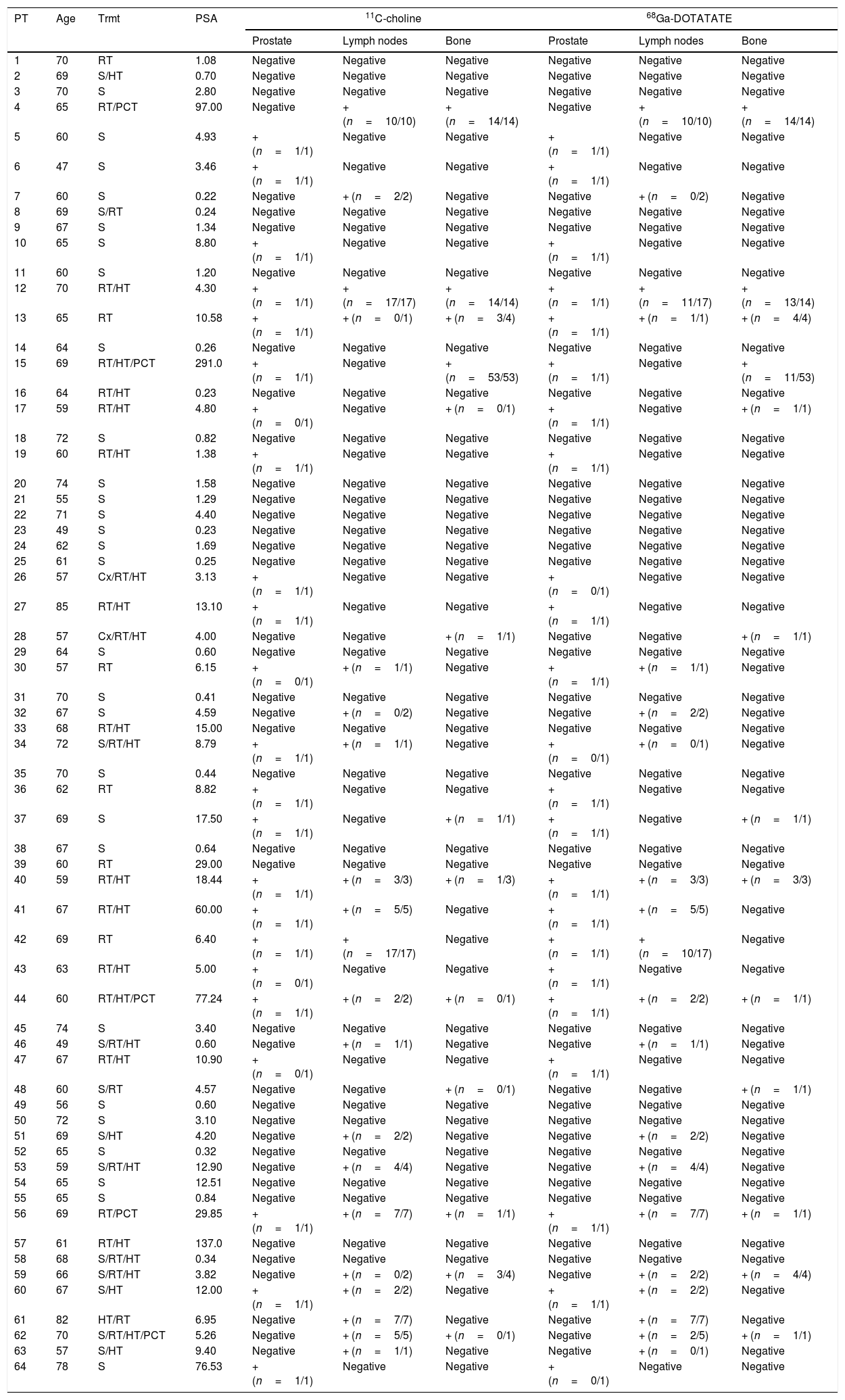To prospectively compare the detection rate of 68Ga-DOTATATE versus 11C-choline PET/CT in patients with prostate cancer in biochemical relapse, and to evaluate somatostatin receptor expression in vivo to plan targeted therapies (177Lu-DOTATATE).
Material and methodsWe prospectively analyzed 64 patients with biochemical relapse (median PSA: 4.25ng/mL). A PET/CT was performed with 11C-choline, and another with 68Ga-DOTATATE. The SUVmax was measured in all lesions. The correlative images, histopathology and/or clinical and biochemical follow-up were taken as the reference standard.
ResultsThe overall detection rate per patient was 48.43% for 68Ga-DOTATATE and 46.87% for 11C-choline. The results were concordant in 53 cases (82.81%). The maximum SUV of 11C-choline was significantly higher than that of 68Ga-DOTATATE for all the concordant lesions (n=130): 6.17 (1.7–15.5) versus 4.38 (1.37–26.7), median (range) for each radiotracer, respectively (p<.0001). The sensitivity and specificity values per patient were the same for both techniques: 0.82 (0.65–0.93) and 0.9 (0.73–0.98), respectively. Although the difference was not significant, the sensitivity was lower in patients with lower PSA levels: 0.63 vs. 0.89; p=.13. A significant correlation was found between the SUVmax of both tracers (r=0.41, n=130, p<.0001).
Conclusions68Ga-DOTATATE PET/CT and 11C-choline PET/CT seem to have a high capacity to detect pathological lesions in the assessment of patients with prostate cancer with biochemical relapse. Further studies are required to test the potential complementary value of these PET/CT techniques, and to evaluate the potential role of 68Ga-DOTATATE for planning somostatin receptor-mediated therapies (177Lu-DOTATATE).
Comparar prospectivamente la tasa de detección de la PET/TC con 68Ga-DOTATATE versus 11C-colina en pacientes con cáncer de próstata en recaída bioquímica y evaluar in vivo la expresión de receptores de la somatostatina con el fin de planificar terapias dirigidas (177Lu-DOTATATE).
Material y métodosAnalizamos prospectivamente 64 pacientes con recaída bioquímica (mediana PSA: 4,25ng/mL). Se realizó una PET/TC con 11C-colina y otra con 68Ga-DOTATATE. Se midió el SUVmáx en todas las lesiones. Se consideraron como patrón de referencia las imágenes correlativas, histopatología y/o seguimiento clínico y bioquímico.
ResultadosLa tasa de detección global por paciente fue del 48,43% para 68Ga-DOTATATE y de 46,87% para 11C-colina. Los resultados fueron concordantes en 53 casos (82,81%). El SUV máximo de la 11C-colina fue significativamente mayor que el correspondiente al 68Ga-DOTATATE para todas las lesiones concordantes (n=130): 6,17 (1,7-15,5) versus 4,38 (1,37-26,7), mediana (rango), para cada radiotrazador, respectivamente (P<0,0001). Los valores por paciente de sensibilidad y especificidad fueron los mismos para ambas técnicas: 0,82 (0,65-0,93) y 0,9 (0,73-0,98), respectivamente. Aunque la diferencia no fue estadísticamente significativa, la sensibilidad fue menor para pacientes con niveles de PSA inferiores: 0,63 vs. 0,89; p=0,13. Se encontró una correlación significativa entre el SUVmáx de ambos trazadores (r=0,41, n=130, p<0,0001).
ConclusionesLa PET/TC con 68Ga-DOTATATE y la PET/TC con 11C-colina parecen poseer alta capacidad de detección de lesiones patológicas en la evaluación de los pacientes con cáncer de próstata en recaída bioquímica. Se necesitan más estudios con el fin de probar el posible valor clínico complementario de estas técnicas PET/TC, y para el 68Ga-DOTATATE para la potencial planificación de terapias mediadas por los receptores de somatostatina (177Lu-DOTATATE).
Article
If you experience access problems, you can contact the SEMNIM Technical Secretariat by email at secretaria.tecnica@semnim.es or by phone at +34 619 594 780.

Revista Española de Medicina Nuclear e Imagen Molecular (English Edition)










